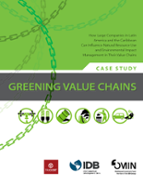Greening Value Chains: How Large Companies in Latin America and the Caribbean Can Influence Natural Resource Use and Environmental Impact Management in Their Value Chains: Case Study
Date
Oct 2016
EDITOR
Hofmann, Michael;Terry, Elizabeth
Micro, small, and medium enterprises (MSMEs) are major sources of natural resource consumption and environmental impacts such as greenhouse gas (GHG) emissions. At the same time, MSMEs make up a large part of the value chains of multinational and publicly traded companies, and thereforeoffer a unique point of entry to improve value chain environmental management practices while simultaneously promoting economic development in the region. In this vein, the Multilateral Investment Fund (MIF), a member of the Inter-American Development Bank (IDB) Group, aims to improve MSME competitiveness through increased efficiency of natural resource inputs, reduction of air and water pollution, gaining higher prices for products that are
certified through reputable green certifications, and increasing MSME sales by strengthening their positioning within the value chains of large companies with sustainability commitments. To inform the MIF's strategic planning on how technical assistance can be best structured to improve the competitiveness of MSMEs in the Latin America and Caribbean (LAC) region through the
promotion of best practices in natural resource management and environmental impact reduction, a study was undertaken by Trucost. As part of this study, Trucost's patented environmental extended input-output (EEIO) model was used to identify five economic sectors in LAC that are associated
with the highest environmental implications regarding inputs (natural resource use) and outputs (environmental impacts) from production processes, specifically relating to the sectors' value chains. For each of these sectors, three large companies were identified for a more focused analysis of
their activities relating to the management of value chain environmental impacts. A case study was developed for one large company per sector to document these in detail. This document summarizes the key findings and lessons learned from the case studies, indicating value chain sectors that can
be targeted to most efficiently reduce value chain environmental impacts, as well as ways in which this targeting can be done.
certified through reputable green certifications, and increasing MSME sales by strengthening their positioning within the value chains of large companies with sustainability commitments. To inform the MIF's strategic planning on how technical assistance can be best structured to improve the competitiveness of MSMEs in the Latin America and Caribbean (LAC) region through the
promotion of best practices in natural resource management and environmental impact reduction, a study was undertaken by Trucost. As part of this study, Trucost's patented environmental extended input-output (EEIO) model was used to identify five economic sectors in LAC that are associated
with the highest environmental implications regarding inputs (natural resource use) and outputs (environmental impacts) from production processes, specifically relating to the sectors' value chains. For each of these sectors, three large companies were identified for a more focused analysis of
their activities relating to the management of value chain environmental impacts. A case study was developed for one large company per sector to document these in detail. This document summarizes the key findings and lessons learned from the case studies, indicating value chain sectors that can
be targeted to most efficiently reduce value chain environmental impacts, as well as ways in which this targeting can be done.




